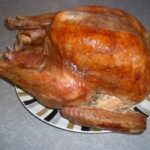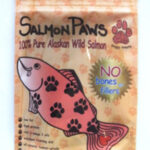People of today still enjoy the convenience and taste of beef jerky. In todays market however, beef jerky can be expensive! For a decent quality, prepackaged beef jerky, the average price is about $4.00 for 2-3 ounces of meat. Making your own jerky is much cheaper and also, in my opinion, produces a much tastier jerky.
Making your own jerky is not as complex as you may think. You can make jerky with many different kinds of meat. I frequently make jerky with beef, turkey and salmon. Beef jerky can be made with cuts of beef or with ground meat. I prefer to use a beef brisket for my jerky, although in a pinch I have used pot roasts, London broil and steak cuts. A beef brisket can be bought trimmed (no fat) or untrimmed (fat is still on the brisket). I personally usually buy the untrimmed brisket for two reasons. One, because it’s generally a little cheaper and two, after I cut the fat off I can boil it to make beef stock to freeze for recipes and feed the cooked fat to my dogs, which really helps to stretch my dollar.
HOW TO PICK A BRISKET
When buying an untrimmed brisket, you want to find one that doesn’t have too much hard fat on it. When packaged, one side of the brisket is predominantly meaty. The other side of the brisket most often appears to be a solid piece of fat. It is the fatty side you need to check. When pressed, most of the fat should “give” to the pressure. There probably will always be a few very hard parts to it, but as long as it’s not all over, it’s OK. Every brisket will be fatty, but the less hard fat your getting, the more meat your getting. You don’t want to waste your money buying fat! If you want to skip some messy work though, save yourself some trouble and just buy a trimmed brisket, because your next step is cutting all that fat off!
GETTING THE MEAT READY
A brisket is usually pretty large. To make things easier for yourself, before attempting to cut off the fat, slice the brisket into more manageable sized pieces. I usually cut mine into approximately 3×3 inch squares or so. There is definitely no exact science to it. Just keep in mind that you are going to be cutting your jerky pieces from these chunks, so you don’t want it to be too small. Once you have your chunks cut, start removing as much of the outer layer of fat as you can. I find that a small, sharp paring knife works best for this. Don’t worry too much about any fat that is running through the meat right now, we’ll get to that in a later step. For now, just concentrate on getting the fat off the outer layer of meat. I cannot stress enough the importance of removing the fat. Fat on meat can go rancid quickly, and if ingested can cause you to get very sick!
Once you have finished removing the fat, place your meat in chunks in zip lock bags, or a freezer safe container. Then place your meat in the freezer and freeze until the meat becomes slightly frozen. (Depending on your freezer, usually between 2-5 hours.) This slight freezing makes slicing the meat so much easier! Using either a meat slicer or a knife with a very sharp blade, start slicing the meat to your desired thickness. (Note: A knife with a smooth blade works best. Serrated knives tend to tear the meat.) The drying time of your meat depends greatly on the thickness you choose. The thicker it is, the longer it takes. I prefer to cut my meat about 1/8-1/4 of an inch thick. Once your meat is sliced, your ready to season.
SEASONING YOUR JERKY
The seasonings you pick depend solely on your taste, and the sky is the limit! There is no reason for you to have to buy special jerky seasoning, you can use almost anything you have in your kitchen. You can use dry seasonings or liquids. If you choose a liquid seasoning, keep in mind that thick, syrupy liquids will stay coated on the meat and could leave a sticky residue on the meat after it is dried.
Some dry seasonings you might use are:
Salt
Lemon Pepper
Pepper
Cajun Seasoning
Garlic Powder/Salt
Jalapeno Salt
Onion Power/Salt
Seasoned Salt
Some liquid seasonings you might use are:
Worcestershire Sauce
Liquid Smoke
Italian Dressing
Soy Sauce
Teriyaki Sauce
Tabasco or hot pepper sauce
Any flavored BBQ sauce
Depending on the amount of meat you have sliced, you can use different seasonings and experiment with different flavors. Place the desired amount of meat into a bowl. Season with your choice of spices or liquids and mix thoroughly to make sure all of the meat is coated. Place the seasoned meat back into the zip lock bags or plastic containers, and place in the refrigerator. The length of time you choose to marinate your meat is also completely up to you. I have taken meat straight from being sliced, unseasoned, and put it directly on my dehydrator, and I like it just as much as seasoned jerky.
DEHYDRATING YOUR MEAT
Once you feel your meat has marinated long enough, it is time to dehydrate it. If you are using a dehydrator, place your meat on the drying racks leaving a small space between the pieces. If you pack too much meat onto the trays, it will take longer to dehydrate, because the air cannot circulate as good. Your meat will be ready when it is crisp. I would suggest leaving the meat on the dehydrator for at least 10-12 hours, however this can vary depending on the thickness of the meat, amount of meat you have on the trays, and the dehydrator itself. You can also dehydrate the meat in your oven. Preheat your oven to a low temp. This temperature can range any where from 110 degrees to 160. The lower the temperature the better though. Remember, you are wanting to dry the meat, not bake it. Place the meat on oven racks, and allow to dry for at least 10-12 hours. One thing that I personally like to do if using my oven to dehydrate, is leave the oven door open a crack, and place a fan next to the oven. This helps to circulate the warm air around, which is what dehydration is all about! Once your meat is dehydrated, pat it with paper towels to absorb any grease that is on it, and store in zip lock bags or an air-tight container.
JUST A FEW EXTRAS
Ground meat can be used to make good beef jerky, and ground meat is the cheapest beef you can usually buy. They make jerky “guns” to make jerky with ground meat. A jerky gun strong resembles a caulking gun. It has a cylinder that you put the meat in, with different attachments to give you different shapes of jerky. You just season your meat, insert in the gun, and pump it out onto your trays. Ground meat jerky is usually VERY greasy however, and you have to pat it with paper towels through out the drying process to get all of the grease off.
You can make jerky with just about any kind of meat. I have seen recipes for jerky made from Venison, Bear, Moose, Emu, Kangaroo, Crocodile, Duck and Goose. It is generally highly recommended to stay away from making chicken or pork jerky however, as these two meats spoil quickly.
Most importantly, have fun with your jerky! Jerky is a versatile treat and can be made to appeal to almost anyones taste. And don’t forget that you can dehydrate many other foods to accompany your jerky, and make tasty and healthy snacks for your family!







